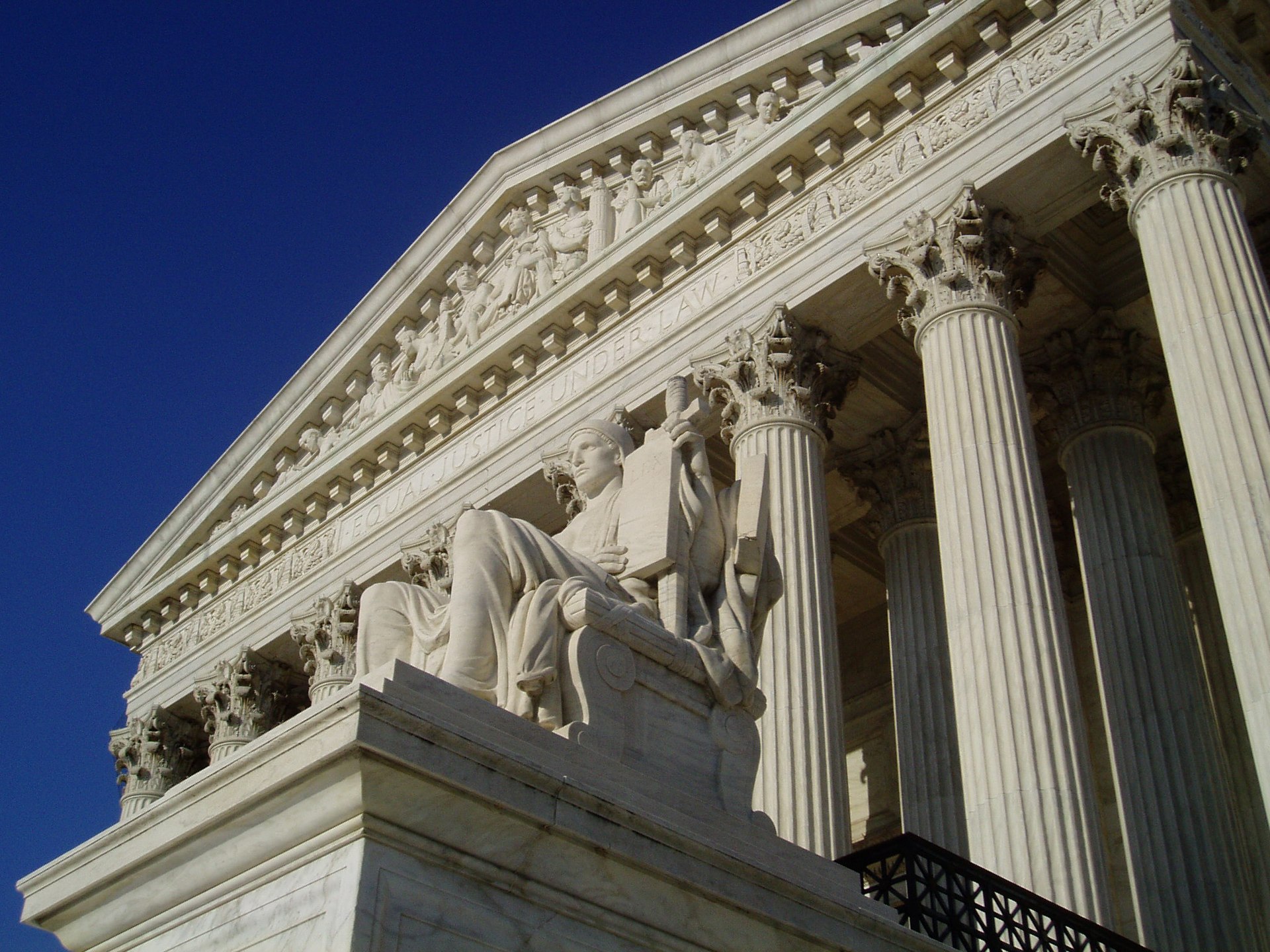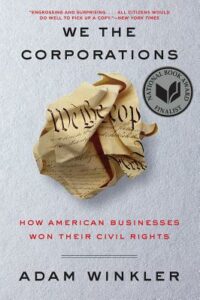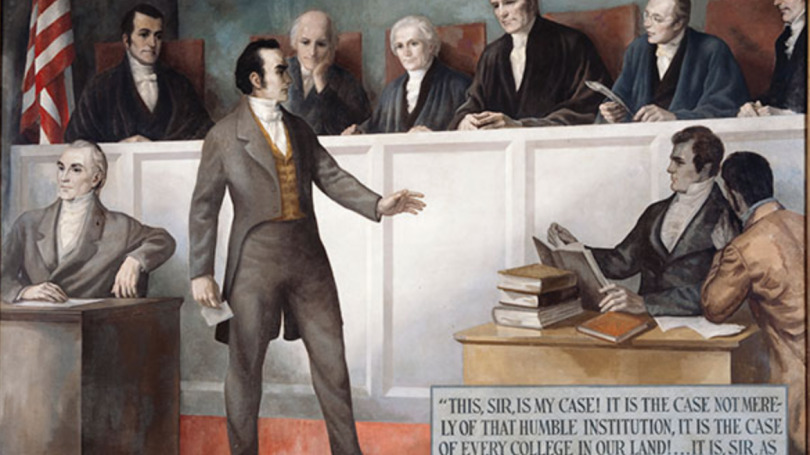Durham, N.C. Adam Winkler teaches law at the UCLA School of Law. His recent book, We the Corporations: How American Businesses Won Their Civil Rights, gives an engaging account of the development of corporate rights, in terms accessible to intelligent non-lawyers as well as intelligent lawyers.
Let’s start this review where the book ends. In 2013, the small county of Mora, in rural New Mexico, prohibited corporations from engaging in fracking within county boundaries. The ordinance speaks eloquently of the political sovereignty of the local people and their right to control their own natural resources, with reverence toward nature. The ordinance had other provisions. It declared that corporations who wanted to challenge the law would not have the rights of persons under the United States or New Mexico constitutions. Corporations, as the ordinance envisioned it, should not have the constitutional rights which should only belong to flesh and blood people.
SWEPI LP, a Delaware corporation which is a subsidiary of the energy company Royal Dutch Shell, and which is authorized to do business in New Mexico, sued Mora County in federal district court to have the county ordinance struck down. The court found that the ordinance clashed with New Mexico state law, but that’s not the important point for present purposes. The court also found that the ordinance violated the United States Constitution, as interpreted by the U. S. Supreme Court. The relevant Supreme Court decisions said that corporations were indeed persons with constitutional rights under the Fourteenth Amendment. Indeed, Mora County recognized this and wanted these Supreme Court precedents overruled. But only the Supreme Court could overrule its own precedents, the trial judge predictably declared. Whatever dreams Mora County may have had of taking its case to the Supreme Court came to an end when the voters, fearing the costs of losing the litigation, replaced a key pro-ordinance member of the county board, after which the county agreed to drop the case.
The rights which the Supreme Court attributed to corporations, to the distress of Mora County, have developed through a series of decisions going back to 1809. Winkler traces these decisions, claiming that the growth of corporate rights was not a spontaneous development but the result of what he sees as a sort of corporate civil-rights movement. Through litigation (generally well-financed) over two centuries, various corporations won decisions by which corporations evolved from government-created artificial persons, not even mentioned by name in the Constitution, into entities possessed of many of the same constitutional rights as flesh-and-blood human beings.
Winkler narrates, as engagingly as he can, the story of the development of corporate constitutional rights in the Supreme Court, with occasional asides for related legal developments in the Supreme or other courts. Winkler starts with an obscure Supreme Court decision in 1809 and builds up his narrative to a climax in 2010 when, in the Citizens United decision, the high tribunal decided that corporations could advertise for or against federal political candidates, despite the efforts of Congress to limit such advertising in the period leading up to general elections. In pursuing his narrative from 1809 to 2010, Winkler gives attention to the stories of the key cases and the lawyers, judges, Presidents, officials, and legislators who developed or fought over these doctrines. Many forceful personalities and influential groups helped pull the law in a pro-corporate direction.
In his history, though he’s not particularly sympathetic to the Citizens United decision, Winkler rejects the idea that the decision was a bolt out of the blue, arbitrarily overturning previous precedents. Responding to the charge that Citizens United was an activist decision, Winkler notes: “While the charge was not completely without foundation, the Citizens United decision also followed well-established patterns drawn over the course of the previous two centuries of corporate rights cases. Citizens United, in other words, is best understood as the most recent manifestation of a long, and long overlooked, corporate rights movement” (326). Rather than being a “constitutional novelty,” Citizens United “was in fact the culmination of a two-hundred-year struggle for constitutional rights for corporations” (369).
The narrative starts with the underappreciated Deveaux case of 1809, which was decided by the Supreme Court, presided over by nationalist Chief Justice John Marshall. The corporation in this case was the Bank of the United States, which was chartered by Congress, in contrast to most corporations then and now which are chartered by states. The same problem applied, though, regardless of who issued the corporate charter: an out-of-state (“foreign”) corporation would (Marshall feared) experience bias at the hands of state courts if they litigated in those tribunals. The solution was to use a U. S. Constitutional clause which provided that the federal courts, rather than state courts, could hear cases involving “citizens” of different states. Corporations could get a more impartial hearing in federal courts, Marshall believed. But how could corporations be “citizens”? At the time, corporations were deemed artificial persons able to own property and appear in court (at least state court), but they were not seen as citizens, a status limited to humans. But corporations were composed of citizens, and Marshall’s court let the citizenship of the members determine the citizenship of the corporation, which in many cases would get a corporation a supposedly better federal forum, free from the vagaries of state justice.
Marshall’s court also gave corporations a temporary victory in the Dartmouth College case. The New Hampshire legislature tried to rewrite the Dartmouth College charter. But on the plea of the great lawyer-politician Daniel Webster, the Marshall Court interpreted the college’s corporate charter as a contract between New Hampshire and the college, and under the U. S. Constitution a state cannot unilaterally amend a contract. This corporate victory was only temporary because, in granting new corporate charters after this decision, states reserved a power to amend charters. There would be no violation of contract if the contract itself allowed for its own amendment.
Under Chief Justice Roger Taney, the Court was somewhat less nationalistic and more oriented to the interests of the states (except where slavery was concerned, when the justices could be nationalistic in favor of the Peculiar Institution). Under Taney, the Court said that a corporation chartered in one state need not have corporate rights, not even access to the courts, in other states. It would all depend on the attitude a state took to “foreign” corporations—it could recognize such corporations, or not. (The Court added that, as a matter of state law, foreign corporations should be presumed to have rights unless specifically barred from enjoying them.)
After the Civil War, the legal landscape changed. A new constitutional amendment—the Fourteenth—was adopted to address the war’s legacy, including the rights of the freed slaves. There are many references to persons in the Fourteenth Amendment, but at first this did not look promising to corporations, since the amendment uses the term “person” to describe those who could be counted in the census and who could have their office-holding rights impaired for supporting the Confederacy. Corporations are not counted in the census and they cannot hold public office, so the term “person” might seem to mean flesh-and-blood humans only. But what about the famous Section 1 of the amendment, guaranteeing to every “person” the right to due process of law and guaranteeing every “person” the equal protection of the law? Could these clauses be interpreted to protect corporations? They could, and they were. Corporate personhood now began to be expanded and used in corporations’ favor.
Here Winkler highlights some dubious maneuvering by corporate champions seeking personhood rights for corporations under the Fourteenth Amendment. Roscoe Conkling, an attorney for a railroad corporation, also happened to have served in Congress, where he helped draft the Fourteenth Amendment. Conkling told the Supreme Court that, from his Congressional experience, he knew the purposes of the Fourteenth Amendment’s drafters, and that one of those purposes was to protect corporations. Conkling even claimed to have a secret diary proving it. Later scholars say Conkling was making up the part about the intent to protect corporations, and the Supreme Court did not use Conkling’s case as the vehicle to put corporate rights into the Fourteenth Amendment. Modern day “originalists”—those who seek to interpret the Constitution and its amendments according to what they consider the ratifiers’ original intention—would not be particularly impressed by Conkling’s “evidence” even if it was true, because it has to do with secret intentions of the drafters, not with the public understanding of the Fourteenth Amendment at the time it was ratified.
Corporate rights did get smuggled into the Fourteenth Amendment, and as Winkler tells it this happened thanks to people who were as sneaky as Conkling had tried to be. The case was Santa Clara County v. Southern Pacific Railroad, and it was a complicated dispute where the railroad tried to claim rights under the equal protection clause of the Fourteenth Amendment, in defense against California’s tax laws. The Supreme Court avoided the constitutional issue and decided the case based on California law, but then a gentleman named J. C. Bancroft Davis muddied the waters. Davis was responsible for publishing the Supreme Court’s decisions, along with summaries of the opinions allowing busy people to get the gist without reading the whole opinion. In summarizing the Santa Clara County decision, Davis imputed to the Court the ruling that corporations are protected by the Fourteenth Amendment’s Equal Protection Clause. Justice Stephen Field, a pro-business justice, took this mistaken summary and ran with it, eventually persuading his colleagues to award equal-protection rights to corporations based on this “precedent.”
Next up was the Fourteenth Amendment’s Due Process clause, which provides that a state cannot deprive a person of life, liberty, or property without due process of law. Prior to the 1930s, the Supreme Court drew some interesting distinctions, declaring that the due process clause applied to corporations so far as the right to property was concerned, but not with respect to the right to liberty—so, for example, a corporation had no freedom of association, which was a liberty right.
Now Winkler takes a bit of a digression from the Supreme Court, and I will use this as the occasion for a digression of my own. During the Theodore Roosevelt administration in the early 1900s, there was a great scandal when insurance companies and other corporations were revealed to have given stockholder money to support Republican candidates for federal office. A Republican politician named Charles Evans Hughes made this discovery, and this launched a public career which would lead to Hughes being Chief Justice of the U.S. (more on this below). President Theodore Roosevelt, a Republican who had received corporate donations, was compelled by public outrage to endorse legislation against future corporate donations to federal candidates. The actual bill embodying this proposal was drawn up by a Democratic Senator, Ben Tillman of South Carolina. Tillman is known to history buffs as a virulent racist, even by the standards of that time. Winkler remarks on this racism, as well as on Tillman’s frequent rhetoric on behalf of states’ rights. With the anti-corporate-donation bill, as Winkler put it, Tillman was “a fair-weather federalist” whose successful Congressional bill was motivated by opposition to Republicans and “Yankee” corporations (218).
So Winkler does briefly note this federalization of the issue of corporations in politics. But throughout the book, however, his discussion of states’ rights is not fully fleshed out. Winkler’s focus is on corporations versus government, whether state or federal, and he does not adopt the old states’ rights view of leaving states with the main responsibility of regulating corporations. Under a states-rights view, discussed in the context of Taney’s corporation opinions but not fully pursued afterwards, a corporation is the creature of the state which created it, with such rights as the state allows it, and if a corporation wants to operate outside its home state it must, as a “foreign corporation,” obtain the consent of the states where it proposes to do business. Winkler, while sympathetic to state regulation of corporations, wants the federal government to be a major player in corporate regulation, which in practice (though Winkler does not go into details here) would seem to partially displace the states from their traditional role, and open the door to one-size-fits-all rules. Part of this comes from a genuinely complicated issue, the conflict between the state power to regulate foreign corporations on the one hand and the Constitution’s protection of interstate commerce on the other hand. These Commerce Clause issues may wipe out state autonomy in corporate regulation just as surely as the Fourteenth Amendment problems Winkler analyzes. More analysis of the Commerce Clause issues would have been helpful.
In the 1930s, with Charles Evans Hughes now the Chief Justice, the Supreme Court decided a press-freedom case with something of a prize for corporate personhood hidden within it. The Louisiana political boss Huey Long had established discriminatory taxes against the large-circulation newspapers which (with one supportive exception) criticized him, while exempting all the small local newspapers which tended to support him. Long made no secret of his intentions to tax opposition newspapers in retaliation for their opposing him. The liberal and conservative justices came together in this case to unanimously reject this discriminatory taxation. In the course of making their decision, the justices, with little explanation, expanded corporate personhood rights. Having previously said that corporations do not have “liberty” rights under the Fourteenth Amendment, now the Court found that newspaper corporations at least have freedom of the press, which is deemed a liberty right. The newspapers involved in this case were all corporations.
Under Chief Justice Earl Warren in the 1950s and 1960s, the Supreme Court expanded corporate liberty rights even more, holding (contrary to earlier precedent) that corporations and their members, when they engage in politics, have the right to freedom of association. The context was the attempt of some Southern states to discover the membership of the NAACP, which was fighting the South over the issue of segregation. Exposing the identities of NAACP members in the South could expose them to physical danger, and the Court found that political groups like the NAACP—which happened to be a nonprofit corporation—had the right to organize their members for political purposes without fear of the kind of retaliation which disclosure of their identities would lead to.
Winkler rightly identifies the newspaper and NAACP cases as precedents for corporate rights, helping build precedents for Citizens United. To many people this will put corporate rights in a better light—if freedom of the press and freedom of association depend on corporate rights, wouldn’t that mean corporate rights are a good thing? Skeptics of corporate rights need to have answers to such questions. My humble suggestion is that it should be considered a violation of the rights of flesh-and-blood persons to practice racial or political discrimination against them by going after the corporations they form. Thus it would violate the rights of a flesh-and-blood newspaper editor to punish him for his viewpoint by excessively taxing his newspaper, and it would violate the rights of a flesh-and blood civil rights activist to use corporate law to uncover his identity and expose him to racist violence.
Winkler gives some examples of Supreme Court decisions which protect corporations under the rationale of protecting their members, or in the case of corporate speech, protecting the would-be listeners who want to hear what a corporation has to say. But Winkler is not fully persuaded by such rationales, since to him they form a backdoor way of smuggling corporate rights into the Constitution.
A key villain for Winkler in the 1970s and 1980s is Supreme Court Justice Lewis Powell, who combined “conservative” corporation-friendly rulings with “liberal” rulings on matters such as abortion and affirmative action. In the bizarre American political spectrum, this all balances out to “moderation,” and the media awarded Powell the coveted “moderate” label. As a corporate attorney, just before joining the bench, Powell wrote a memorandum urging businesses to become more militant in defending free enterprise against government regulation—Winkler gives this memo some of the credit for renewed business activism leading to the Reagan era. Powell continued his defense of corporate rights as a Justice—sometimes provoking states’-rights dissents by conservative justice William Rehnquist (later Chief Justice). Winkler seems appreciative of Rehnquist’s states’-rights proclivities when they led to anti-corporation votes, but again, Winkler does not fully develop the idea of states’ rights in the corporate regulation context.
In any case, as Winkler acknowledges, there were longstanding precedents which the Supreme Court was able to rely on in giving its Citizens United decision. But that decision still shocked much of the public, which thought the last thing the country needed was more corporate influence in politics. Some critics also questioned the appropriateness of using investor funds for partisan campaigns, especially since investors generally do not pick and choose what stocks to buy, but own shares in corporations selected by, say, their pension funds. They might find themselves, contrary to their wishes, supporting political causes they opposed through the stocks they own, without a lot of practical recourse.
Winkler’s bottom line is that he seems to wish both state and federal governments to have broader authority to regulate corporations, and that the two-hundred-year course of pro-corporate decisions by the Supreme Court took the country in the wrong direction with excessive recognition of corporate rights. What the author does not fully grapple with is the vision of corporate regulation as a state matter. Of course, if states recover their constitutional responsibilities over corporations, the people and their representatives would need to have a lot of accumulated virtue to resist the attempt by gigantic corporations to buy them off. If states’ rights—or even local community rights—means selling the privileges of popular government back to the corporations, we will have returned to where we started.










2 comments
Gabe Ruth
Thanks for the fantastic review. I have long been mystified that the dormant commerce clause is not looked at more skeptically by many people.
To me the most practical reason not to treat corporations as people is that they can be effectively immortal. Maybe there could be an estate tax analog every time there’s a new CEO or something.
Brian
IANAL, but it’s beyond me how anyone can argue that the New York Times, a corporation, has the right to speak on political matters when and how it wants to, but Citizens United, also a corporation, does not. In this time of widespread speech suppression in service of the utterly farcical goal of “fighting misinformation”, there’s plenty of other aspects of corporate law that people can and should focus on rather than that.
Comments are closed.